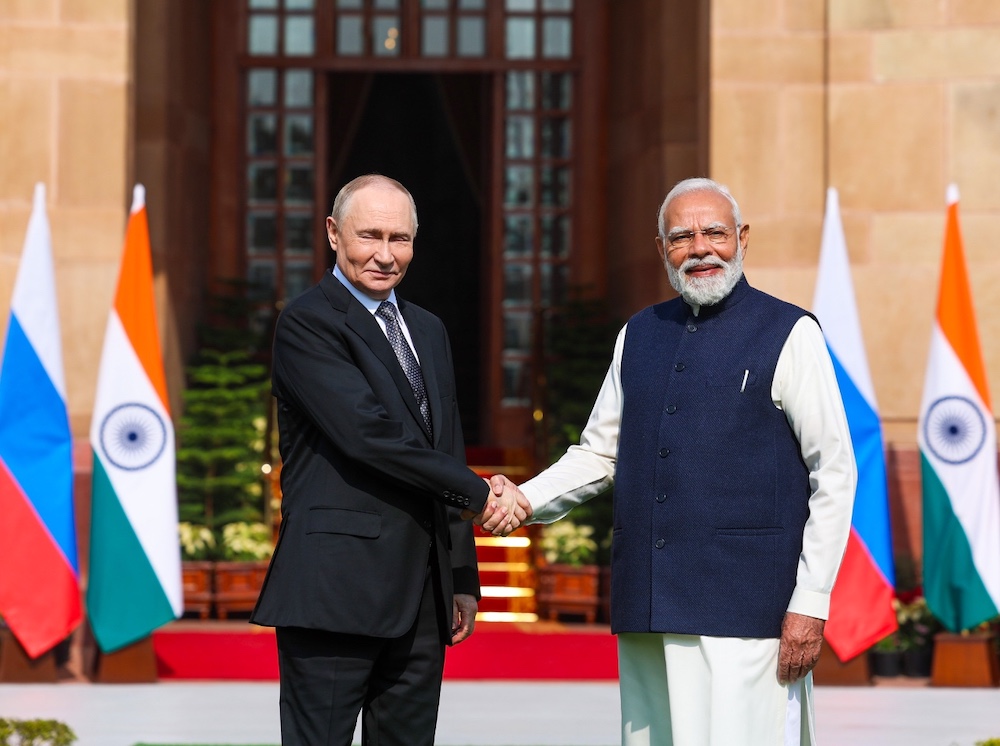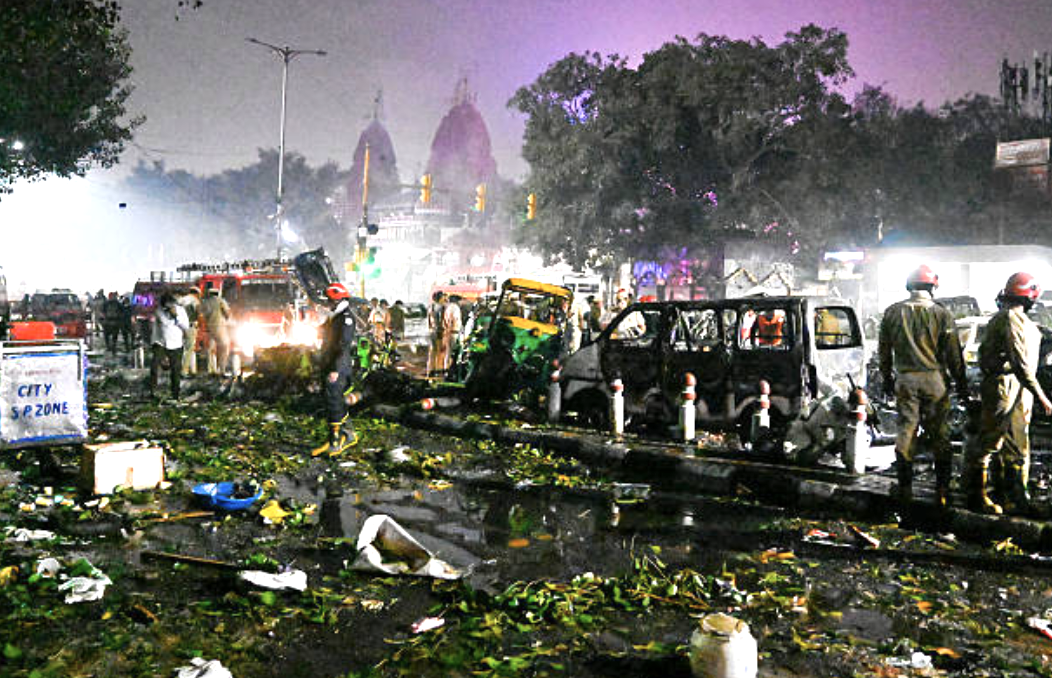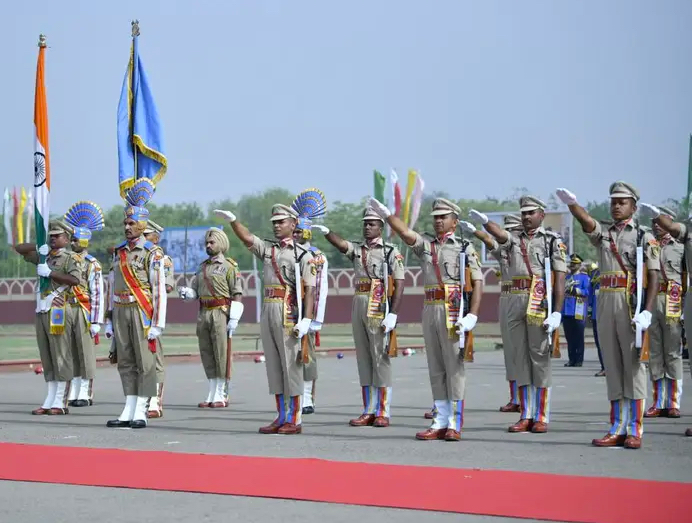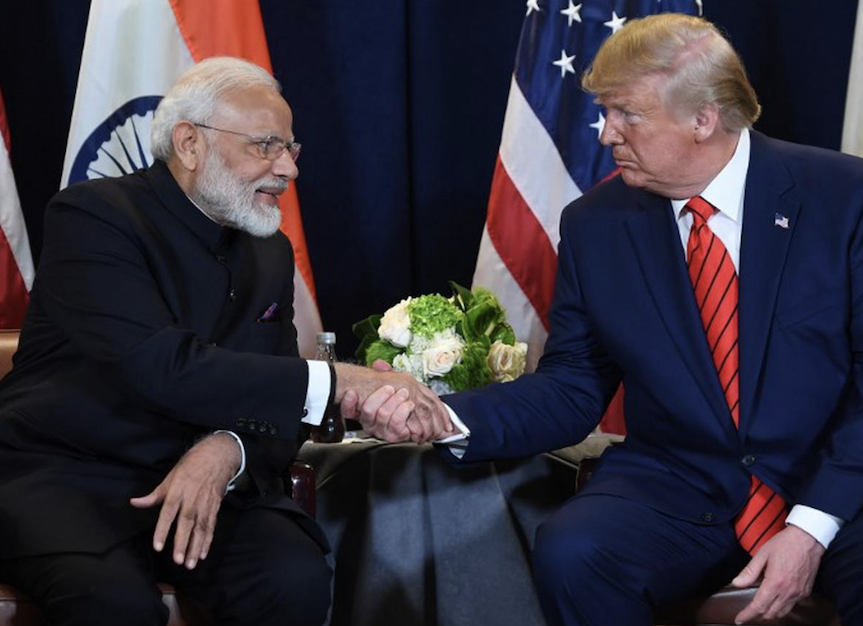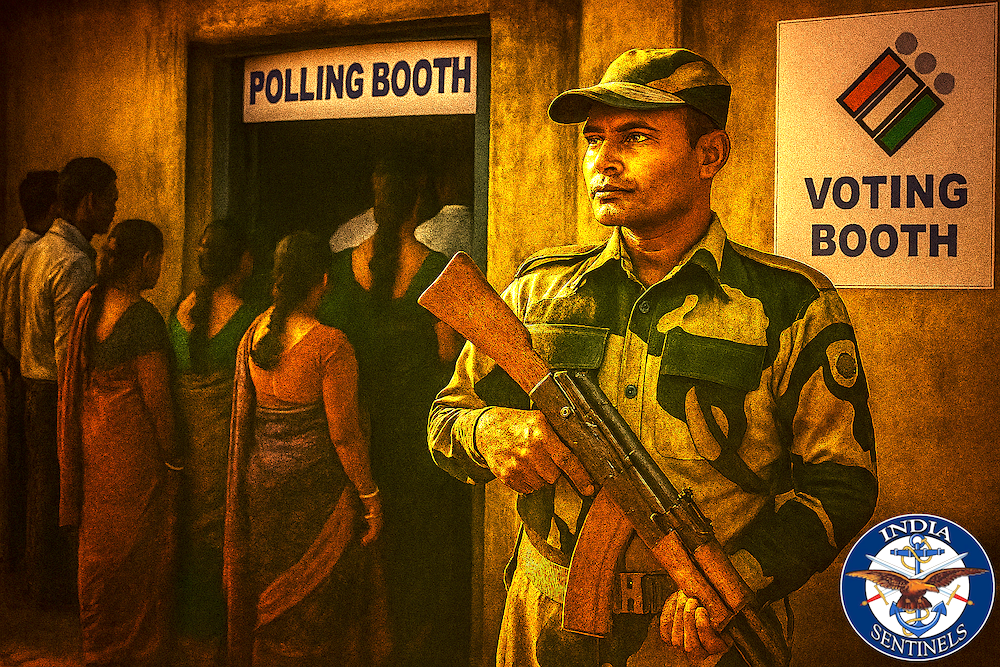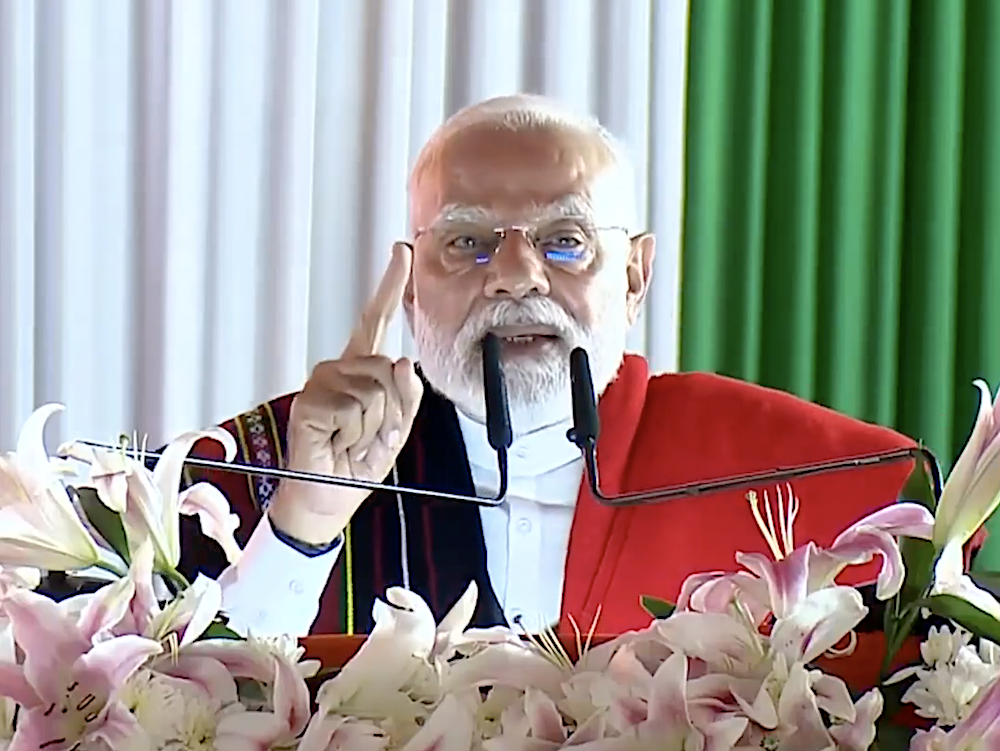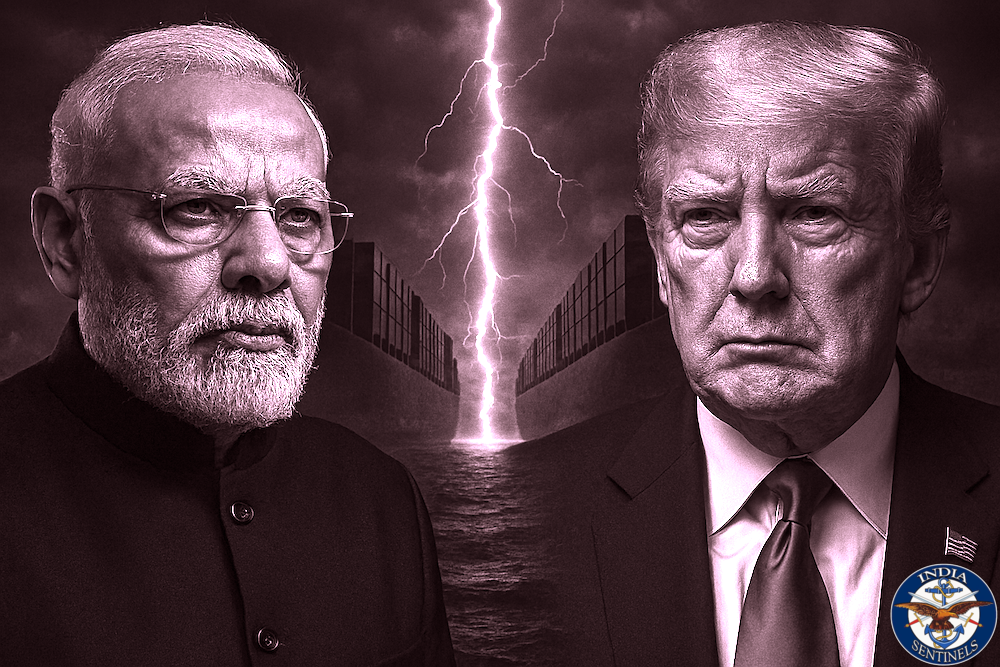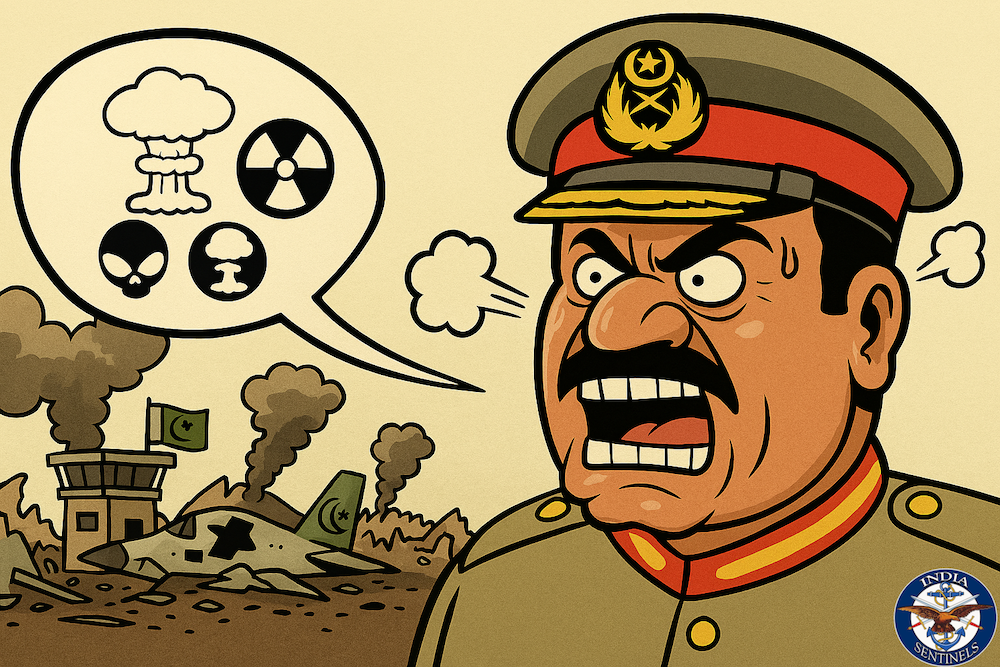 Illustration for representation. (© India Sentinels 2025–26)
Illustration for representation. (© India Sentinels 2025–26)
When Pakistan’s army chief, Field Marshal Asim Munir, stood on American soil in Tampa, Florida, and declared that Pakistan would “take half the world down with us” if it felt threatened, he crossed a line that should alarm every responsible nation. This wasn’t merely sabre-rattling from a besieged military establishment – it was nuclear blackmail delivered from the territory of the world’s most powerful democracy, apparently with its tacit blessing.
As someone who has spent nearly four decades studying Pakistan’s strategic behaviour, this author can attest that these threats represent something more complex than simple bluster. They reveal a nation in the throes of a multifaceted crisis, wielding its nuclear arsenal not as a defensive shield but as a desperate attempt to maintain relevance after a humiliating military defeat.
Read also: Thank you, Trump, for making India understand America like never before
Bitter Aftertaste of Op Sindoor
Let us begin with the immediate catalyst. Operation Sindoor in May 2025 shattered Pakistan’s carefully cultivated myth of military parity with India. Our precision strikes destroyed nine terrorist camps across Pakistan and Pakistan-occupied Kashmir, including the nerve centres of Lashkar-e-Taiba in Muridke and Jaish-e-Muhammed in Bahawalpur. More significantly, we struck 11 Pakistani airbases, effectively neutralizing their nuclear-delivery capacity via air vectors.
The psychological impact of this operation cannot be overstated. When Indian aircraft struck Nur Khan airbase – mere kilometres from Rawalpindi’s General Headquarters and Islamabad itself – it demolished Pakistan’s strategic assumption of geographical immunity. For the first time, the Pakistan military confronted an uncomfortable truth: India could conduct deep strikes with impunity, and Pakistan’s nuclear deterrent had failed to prevent conventional military action.
In military parlance, this is what we call a “deterrence failure”. Pakistan had long operated under the assumption that its nuclear weapons provided an umbrella beneath which it could conduct terrorism with impunity. Operation Sindoor demonstrated that India had successfully called this nuclear bluff.
Munir’s threats, therefore, represent psychological compensation for battlefield defeat. When a military establishment loses decisively, nuclear rhetoric becomes the last refuge – a tool to restore perceived parity when conventional capabilities have been exposed as inadequate. The threats are less about deterring future Indian action and more about salvaging the Pakistan Army’s reputation domestically, where military prestige is paramount.
Read also: How Trump lost India – and why America must win it back
Doctrine and Desperation
Unlike India’s principled “no first use” nuclear doctrine, Pakistan maintains a “first use” policy specifically designed to offset our conventional military superiority. This doctrine encompasses what Islamabad euphemistically calls “full-spectrum deterrence”, which includes tactical nuclear weapons like the Nasr missile system.
Pakistani strategists have codified nuclear escalation into four thresholds: public or private warnings, demonstration tests on Pakistani soil, use against foreign forces on Pakistani territory, and finally, strikes against military targets on foreign soil. Munir’s threats fit squarely within this doctrinal framework – they are not aberrations but logical extensions of Pakistan’s stated policy.
However, doctrine alone does not explain the unprecedented frequency and explicitness of these recent threats. What we are witnessing is the weaponization of nuclear rhetoric to serve multiple simultaneous purposes, most of which have little to do with genuine strategic deterrence.
Read also: Charting India’s Strategic Autonomy – A perspective on geopolitical reset
Diversionary Imperative
Pakistan in 2025 faces a convergence of internal crises that would challenge any government. The ongoing persecution of former prime minister Imran Khan has created massive political instability. On the second anniversary of Khan’s imprisonment this August, nationwide protests erupted with over 240 activists arrested. The PTI’s popularity, despite systematic suppression, represents an existential challenge to military dominance.
Simultaneously, Pakistan finds itself in a dangerous border conflict with Taliban-controlled Afghanistan. The October clashes, which saw Pakistani airstrikes in Kabul followed by Taliban retaliation killing at least 23 Pakistani soldiers, represent a profound strategic irony: the very jihadist forces Pakistan nurtured for decades are now attacking it.
The economy remains in perpetual crisis, dependent on its 25th IMF bailout since 1958. The military’s vast economic empire – the Fauji Foundation valued at $5.9 billion, Army Welfare Trust, Defence Housing Authority – has failed to deliver sustainable growth. Instead, 44.7% of Pakistan’s population live below the poverty line while senior officers enrich themselves through military-controlled businesses.
Nuclear threats against India serve as a classic diversionary tactic, redirecting public attention from internal failures toward the external enemy. For a military establishment facing domestic criticism, aggressive posturing against India helps justify the army’s dominant political and economic role. Munir’s promotion to field marshal despite military defeat suggests an attempt to consolidate power through nationalist rhetoric.
Read also: As Sergio Gor lands, India must map its own course amid Trump’s SA reset
Terror-Nuclear Nexus
Pakistan has perfected a dangerous formula: conduct terrorist attacks against India while threatening nuclear escalation if India retaliates conventionally. This pattern was evident after the 2001 Parliament attack, 2008 Mumbai massacre, 2016 Uri strike, 2019 Pulwama bombing, and 2025 Pahalgam attack.
Operation Sindoor disrupted this formula by demonstrating that India could strike deep into Pakistan despite nuclear threats. Munir’s renewed rhetoric attempts to restore the “strategic space” for Pakistan’s terror proxies by deterring future Indian responses and mobilizing international pressure on India to exercise “restraint”.
This is where nuclear blackmail becomes most insidious – it transforms Pakistan’s terrorism into an international crisis rather than what it truly is: state-sponsored violence that demands punishment, not mediation.
Read also: India’s Eastern Front – The new battleground that could eclipse Pak
China – A Dangerous Enabler
Recent conflicts revealed the extent of Chinese military support to Pakistan. As this author had written before, during Operation Sindoor, Pakistan operated almost entirely on Chinese hardware – J-10C fighters, JF-17 aircraft, HQ-9 air-defence systems, PL-15 missiles, Wing Loong II drones. More concerning, China reportedly provided AI-based data link systems, Beidou/Gaofen/Yaogan satellites for intelligence, surveillance and reconnaissance, and real-time sensor fusion.
Security analysts, including this author, believe China used the India-Pakistan conflict as a testing ground for its weapons systems and network-centric warfare capabilities against Indian forces in real combat conditions. This represents a form of proxy warfare where China gains valuable intelligence about Indian capabilities without direct military engagement.
With comprehensive Chinese military backing, Pakistan feels emboldened to issue nuclear threats, knowing Beijing has a strategic interest in preventing Pakistani defeat. The objective is clear: create a credible two-front threat scenario for India, forcing us to divide our attention and resources between the Himalayan frontier and Pakistan.
Read also: China’s Brahmaputra Gambit: A strategic assessment of Motuo dam
Trump Factor
The most disturbing aspect of Pakistan’s nuclear posturing is the apparent tacit approval from the Trump administration. In June – just a month after Operation Sindoor, Munir became the first Pakistani army chief hosted for a private White House lunch by a sitting American president without civilian leaders present. He has met Donald Trump at least three times in 2025, receiving public praise for his role in “preventing nuclear war”.
The critical minerals dimension cannot be ignored. Pakistan signed a $500 million partnership with US Strategic Metals, a Clayton, Missouri-based company, offering access to rare earth elements, antimony, copper, and other critical minerals. Pakistan claims $8 trillion in total mineral wealth, though realistic estimates are substantially lower.
For Trump’s transactional administration, this deal offers diversification away from Chinese dominance in rare earths and critical minerals essential for defence, clean energy, and advanced manufacturing. Pakistan has also nominated Trump for the Nobel peace prize for his alleged mediation role – a transparent attempt to curry favour.
What makes this truly alarming is that Munir issued his most explicit nuclear threat from American soil. No nation has previously allowed another country’s military leader to threaten a third nation with nuclear annihilation from its territory. The muted American response – merely reiterating that relations with India and Pakistan “remain unchanged” – signals at least tacit approval.
This represents a dangerous precedent. If the United States tolerates nuclear threats from its soil in exchange for minerals deals, it fundamentally undermines the global non-proliferation regime and emboldens nuclear blackmail as a legitimate tool of statecraft.
Read also: Network-Centric Warfare – Pakistan’s edge and India’s wake-up call
Tactical Nuke Trap
Pakistan’s development of tactical nuclear weapons, like the Nasr missile, represents a dangerous lowering of the nuclear threshold. These battlefield weapons, designed for forward deployment, face higher risks of loss of control during conflict. Pakistani strategists argue these were necessary to counter India’s “cold start” doctrine, but the reality is more sinister.
Tactical nuclear weapons make nuclear war more likely, not less. They blur the distinction between conventional and nuclear conflict, increasing the probability of miscalculation. During a crisis, forward-deployed tactical weapons face “use them or lose them” pressures that could trigger nuclear exchange.
Former Pakistani officials have acknowledged this danger. The Trump administration itself has expressed concern that tactical nuclear weapons “are more susceptible to terrorist theft and increase the likelihood of nuclear exchange in the region.” Yet Pakistan continues to expand this arsenal, and its threats increasingly reference these weapons.
Read also: Beijing cannot dictate the Dalai Lama’s reincarnation
Saudi Security Blanket
In September this year, Pakistan entered a mutual defence pact with Saudi Arabia stipulating that “any aggression against either country shall be considered an aggression against both.” This gives Pakistan enhanced security confidence to pursue aggressive military objectives.
The Saudi connection reflects broader regional calculations. With Chinese military support, American minerals deals, and Saudi security guarantees, Pakistan believes it has assembled an coalition that provides strategic depth against India. This perception of enhanced backing emboldens nuclear rhetoric.
Read also: With FM Munir in Pakistan’s charge, India must see the ‘black swan’ coming
Pakistan’s ‘Deterrence Anxiety’
As India continues modernizing our military capabilities – ballistic missile defence, nuclear-powered submarines, advanced weapons systems – Pakistan experiences what strategists call “deterrence anxiety”. The fear that its nuclear arsenal may not sufficiently deter Indian conventional action drives increasingly shrill threats.
Pakistan’s former UN permanent representative and geopolitical analyst Maleeha Lodhi has argued that India’s military modernization and offensive doctrines have “undermined” the region’s strategic equilibrium. This reveals a fundamental misunderstanding: there never was equilibrium between a democracy that abhors terrorism and a military state that employs it as policy.
India’s strategic challenge is managing Pakistan’s nuclear blackmail without being deterred from legitimate defensive actions. Operation Sindoor demonstrated that this is possible. We must continue developing capabilities that allow us to respond to terrorism with precision while managing escalation risks.
Read also: India mustn’t take Pakistan COAS’s promotion to field marshal lightly
The Ultimate Irony
Pakistan’s nuclear threats reveal a fundamental paradox. A nation that lost decisively in conventional combat, faces multiple internal crises, depends on foreign bailouts, and relies on terrorism as state policy nonetheless wields nuclear weapons to maintain relevance.
These threats represent not strength but strategic desperation – an attempt to preserve the military establishment’s power through nuclear blackmail when all other levers have failed. The military controls tens of billions of dollars through business entities, yet the economy remains in crisis. It cannot win conventional wars, so it threatens nuclear annihilation. It cannot govern effectively, so it manufactures external threats.
The international community must recognize Pakistan’s nuclear threats for what they are: not legitimate deterrence but blackmail by a failing state attempting to shield terrorism. The Trump administration’s apparent approval, motivated by short-term minerals access, represents a dangerous departure from responsible nuclear stewardship.
India must continue demonstrating that we will not be deterred by nuclear blackmail from taking legitimate defensive action against terrorism. We must simultaneously pursue military modernization while maintaining strategic restraint and working with responsible nations to isolate Pakistan’s reckless nuclear rhetoric.
The world has seen nuclear weapons used as shields for peace. In Pakistan’s hands, they have become shields for terrorism. That distinction must guide international responses to Munir’s threats. Anything less rewards nuclear blackmail and makes the world more dangerous for everyone.
Disclaimer: The views expressed in the article are the author’s own and don’t necessarily reflect the views of India Sentinels.
Follow us on social media for quick updates, new photos, videos, and more.
X: https://twitter.com/indiasentinels
Facebook: https://facebook.com/indiasentinels
Instagram: https://instagram.com/indiasentinels
YouTube: https://youtube.com/indiasentinels
© India Sentinels 2025-26

